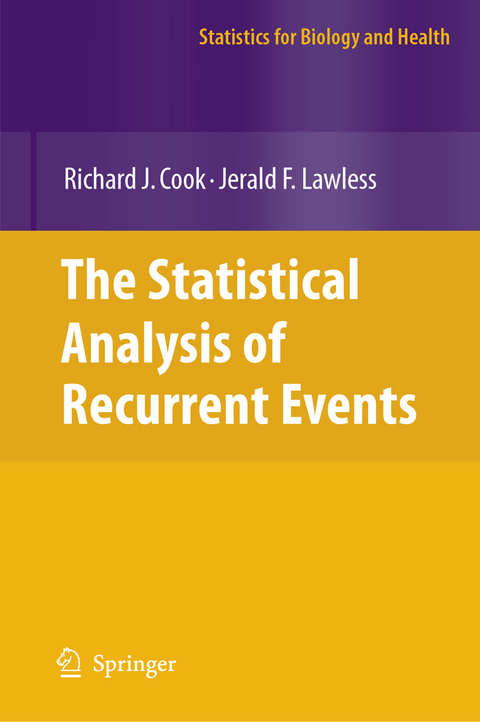
The Statistical Analysis of Recurrent Events
Seiten
2010
|
Softcover reprint of hardcover 1st ed. 2007
Springer-Verlag New York Inc.
978-1-4419-2415-5 (ISBN)
Springer-Verlag New York Inc.
978-1-4419-2415-5 (ISBN)
Important practical topics such as observation schemes and selection of individuals for study, the planning of randomized experiments, events of several types, and the prediction of future events are considered.Methods of modeling and analysis are illustrated through many examples taken from health research and industry.
Recurrent event data arise in diverse fields such as medicine, public health, insurance, social science, economics, manufacturing and reliability. The purpose of this book is to present models and statistical methods for the analysis of recurrent event data. No single comprehensive treatment of these areas currently exists. The authors provide broad but detailed coverage of the major approaches to analysis, while also emphasizing the modeling assumptions that they are based on. Thus, they consider important models such as Poisson and renewal processes, with extensions to incorporate covariates or random effects.
More general intensity-based models are also considered, as well as simpler models that focus on rate or mean functions. Parametric, nonparametric and semiparametric methodologies are all covered, with clear descriptions of procedures for estimation, testing and model checking. Important practical topics such as observation schemes and selection of individuals for study, the planning of randomized experiments, events of several types, and the prediction of future events are considered.
Methods of modeling and analysis are illustrated through many examples taken from health research and industry. The objectives and interpretations of different analyses are discussed in detail, and issues of robustness are addressed. Statistical analysis of the examples is carried out with S-PLUS software and code is given for some examples.
This book is directed at graduate students, researchers, and applied statisticians working in industry, government or academia. Some familiarity with survival analysis is beneficial since survival software is used to carry out many of the analyses considered. This book can be used as a textbook for a graduate course on the analysis of recurrent events or as a reference for a more general course on event history analysis. Problems are given at the end of chapters to reinforce the material presented and to provide additional background or extensions to certain topics.
Recurrent event data arise in diverse fields such as medicine, public health, insurance, social science, economics, manufacturing and reliability. The purpose of this book is to present models and statistical methods for the analysis of recurrent event data. No single comprehensive treatment of these areas currently exists. The authors provide broad but detailed coverage of the major approaches to analysis, while also emphasizing the modeling assumptions that they are based on. Thus, they consider important models such as Poisson and renewal processes, with extensions to incorporate covariates or random effects.
More general intensity-based models are also considered, as well as simpler models that focus on rate or mean functions. Parametric, nonparametric and semiparametric methodologies are all covered, with clear descriptions of procedures for estimation, testing and model checking. Important practical topics such as observation schemes and selection of individuals for study, the planning of randomized experiments, events of several types, and the prediction of future events are considered.
Methods of modeling and analysis are illustrated through many examples taken from health research and industry. The objectives and interpretations of different analyses are discussed in detail, and issues of robustness are addressed. Statistical analysis of the examples is carried out with S-PLUS software and code is given for some examples.
This book is directed at graduate students, researchers, and applied statisticians working in industry, government or academia. Some familiarity with survival analysis is beneficial since survival software is used to carry out many of the analyses considered. This book can be used as a textbook for a graduate course on the analysis of recurrent events or as a reference for a more general course on event history analysis. Problems are given at the end of chapters to reinforce the material presented and to provide additional background or extensions to certain topics.
Models and Frameworks for Analysis of Recurrent Events.- Methods Based on Counts and Rate Functions.- Analysis of Gap Times.- General Intensity-Based Models.- Multitype Recurrent Events.- Observation Schemes Giving Incomplete or Selective Data.- OtherTopics.
| Erscheint lt. Verlag | 23.11.2010 |
|---|---|
| Reihe/Serie | Statistics for Biology and Health |
| Zusatzinfo | XX, 404 p. |
| Verlagsort | New York, NY |
| Sprache | englisch |
| Maße | 155 x 235 mm |
| Themenwelt | Mathematik / Informatik ► Mathematik ► Statistik |
| Medizin / Pharmazie ► Medizinische Fachgebiete | |
| Studium ► Querschnittsbereiche ► Epidemiologie / Med. Biometrie | |
| Studium ► Querschnittsbereiche ► Prävention / Gesundheitsförderung | |
| Sozialwissenschaften ► Soziologie | |
| Technik ► Maschinenbau | |
| Wirtschaft ► Volkswirtschaftslehre ► Ökonometrie | |
| ISBN-10 | 1-4419-2415-9 / 1441924159 |
| ISBN-13 | 978-1-4419-2415-5 / 9781441924155 |
| Zustand | Neuware |
| Haben Sie eine Frage zum Produkt? |
Mehr entdecken
aus dem Bereich
aus dem Bereich
ein überfälliges Gespräch zu einer Pandemie, die nicht die letzte …
Buch | Hardcover (2024)
Ullstein Buchverlage
24,99 €


